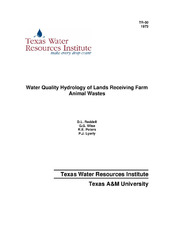| dc.description.abstract | A significant pollution potential from cattle manure has developed as a result of the cattle feeding industry progressing to large, high density feeding operations. Two major potential sources of pollution from beef feedlots is storm runoff and solid waste (manure).
The objectives of this research were to determine the characteristics of storm runoff from a beef feedlot, to determine the nitrogen transformations and ammonia volatilization from soils receiving large manure applications, to determine the chemical quality of surface runoff and groundwater from plots receiving large manure applications, to evaluate techniques of deep plowing large amounts of manure into the soil, and to determine the crop quality and yields on field plots receiving large manure application rates.
Feedlot runoff was found to carry large amounts of chemical elements. The concentrations of chemical elements did not vary with size and intensity of rainstorm as much as by differences in topography of the watersheds.
More ammonia was volatilized from limed soil columns than unlimed but an unexplained decrease in total nitrogen of 10 to 20 percent occurred in the unlimed and limed soil columns, respectively.
A 30-in. moldboard plowing 30 to 36-in. deep can safely turn under up to 900 tons/acre of manure and not create a major surface water pollution problem. An increase of chemical elements in the groundwater occurred during the first year and then were reduced to initial values during the second year. No N03 pollution of groundwater occurred.
Crops can be effectively grown on land receiving up to 900 tons/acre of manure. Peak yields will not be obtained the first year after plowing the 900 tons under, but yields will increase the second and third years. | en |


